Allons, Alpes-de-Haute-Provence
Allons is a commune in the Alpes-de-Haute-Provence department in the Provence-Alpes-Côte d'Azur region of southeastern France.
Allons
Alonh | |
|---|---|
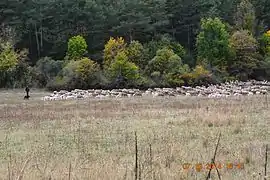 Herding sheep in Allons | |
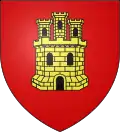 Coat of arms | |
Location of Allons | |
 Allons 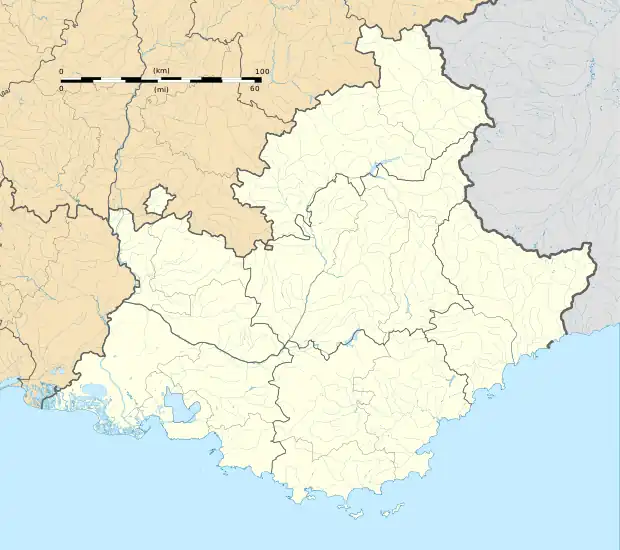 Allons | |
| Coordinates: 43°58′42″N 6°35′45″E | |
| Country | France |
| Region | Provence-Alpes-Côte d'Azur |
| Department | Alpes-de-Haute-Provence |
| Arrondissement | Castellane |
| Canton | Castellane |
| Intercommunality | Alpes Provence Verdon - Sources de Lumière |
| Government | |
| • Mayor (2020–2026) | Christophe Iacobbi[1] |
| Area 1 | 41.71 km2 (16.10 sq mi) |
| Population | 128 |
| • Density | 3.1/km2 (7.9/sq mi) |
| Time zone | UTC+01:00 (CET) |
| • Summer (DST) | UTC+02:00 (CEST) |
| INSEE/Postal code | 04005 /04170 |
| Elevation | 951–1,992 m (3,120–6,535 ft) (avg. 1,073 m or 3,520 ft) |
| 1 French Land Register data, which excludes lakes, ponds, glaciers > 1 km2 (0.386 sq mi or 247 acres) and river estuaries. | |
The inhabitants of the commune are known as Allonsais or Allonsaises[3]
Geography
Allons occupies an area mainly located in the small valley of the Ivoire, a tributary of the Verdon, away from the main road of the valley of the Verdon some 60 km north-west of Nice and 40 km south-east of Digne. There are two natural closures of the site, one at Vauclause which corresponds to the edge of the commune at the valley of the Verdon, the other immediately at the exit of the village where the remains of a fortification can be seen.
The village is situated at 1073 m altitude.[4]
The only access to the commune is via road D52 which runs south-east to the village from Road D955 some 6 km north-east of Saint-Andre-les-Alpes.[5]
Relief
The commune is mountainous with high points including:
- Puy de Rent (1996 m)
- Le Puy (1820 m)
- Basse d'Allons (1493 m)
- Le Roncheret (1617 m)
- Le Puel (1532 m)
- Col de l'Iscle (1394 m)
- Montagnone (1775 m)
- Chamatte
- Basse d'Angles
- Serres (1778 m at Serre Gros)
Hydrography
The commune is traversed by the Ivoire stream into which many streams flow from the mountains. The Ivoire flows into the Verdon[6] (a tributary of the Durance), which forms the north-western border of the commune.
Flora
The commune is a Drainage basin oriented east-west resulting in a large shady side and a large south-facing slope. On the shady side, there are Pine forests.[7] There is a forest of beech trees growing near the village.[7] A Riparian forest with abundant willow trees grows along the Ivoire stream.[7]
Transport
There is a railway station at the intersection of the roads called Allons-Argens Halt which is an optional stop on the metre-gauge Nice to Digne line of the Chemins de Fer de Provence.[8]
Hamlets
- La Moutiere
- La Forêt
Neighbouring communes and towns
Natural and technological hazards
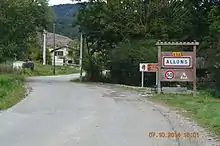
The area to which Allons belongs is in zone 1b (low risk) according to the deterministic classification of 1991, based on historical earthquakes[9] (medium risk), and in zone 4 according to the classification probability EC8 of 2011.[10] The common Will also faces three other natural hazards:[10]
- forest fire,
- flood, marginally in the valley of the Verdon)
- landslide: the community is affected by a medium hazard high on the slope located above Vauclause in the valley of the Verdon[9]
- avalanche
The commune is not exposed to any risk of technological origin identified by the prefecture[9] and no prevention plan for foreseeable natural risks (PPR) exists for the commune,[9] the DICRIM has existed since 2011.[11]
The commune was the subject of one natural disaster in 1994 for flooding and mudslides.[10]
Toponymy
The village is mentioned for the first time in the charters of 1113 (in the form Alonz). This place name is formed from the Germanic proper name Alonius according to Ernest Nègre.[12] Charles Rostaing and Fénié argue that the name was formed from the orographic root (in relation to the mountains) Al- (as in the word alpe).[13][14] This root is probably older than the Gallic.[15]
History
An oppidum occupied the site of Castellas in the Iron Age.[16] Augustus conquered the valley of the Verdon at the same time as the Alps, which he completed in 14 BC. It is difficult to know the name of the Gallic tribe that inhabited the valley nor the name of the civitas on which Allons depended in the High Empire: Eturamina (Thorame), Civitas Saliniensum (Castellane), or Sanitensium (Senez). At the end of the Roman Empire, the connection to Sanitensium and its diocese seem to be proven.[17]
A bronze statue from Antiquity was once found in the commune (now lost).[18]
Middle Ages
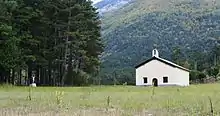
It is possible that the Chapel Saint-Domnin at La Moutiere was built on the site occupied by the Allons community in the High Middle Ages in connection with a first monastery. On the opposite side of the valley there are several names of Villas that reinforce this hypothesis.[16] The site of the upper Town, in the valley is possibly contemporary.[16]
In 1072, Pons Sylvain (Pontius Silvanus) owned an important part of the area, if not the entire valley. He donated land to the abbey of Saint-Victor de Marseille which established the priory of Saint Martin there at the end of the 11th to the beginning of the 12th centuries. The village of Allons was created shortly after around a new church which was also called Saint Martin and the priory was abandoned in the 13th century.[16]
The fief belonged to the bishops of Senez and then to the Abbey of St. Victor, Marseille.[19]
The Allons community was under the viguerie of Castellane.[7][16] Three recognisable structures were found in the village that housed various noble families, among which were that of Requiston and Richery (joint lords),[7] Villeneuve, and Autane - the last two being lords of the fief from 1757 to the French Revolution.[7] These buildings are similar to castles, the largest of them is that of Autane located on the square of the same name, it surprises by its large size and the 17th century style unusual in the region. Since the Revolution the castle has been divided between several owners, and several changes have been made - especially on the roof. The most important lords were the Requiston family.[4]
In 1390, Raymond de Turenne laid siege to the Vauclause castle.
The story of Allons is also linked to that of Vauclause - a rocky outcrop overlooking the entrance to the valley of the Ivoire. In the Middle Ages a community was located there near a castle of which only a few walls remain. This community had twelve fires in 1315[19] and had no church.[16] It was drastically depopulated by the crises of the 14th century (the Black Death and the Hundred Years War) and was annexed by Allons.[19] The fief of Vauclause was distinct from that of Allons, and remained until the Revolution.[7] Today there is a large farm that is the subject of restoration.
From the late Middle Ages to the French Revolution
In 1745 the people rebelled against a demand by the Bishop of Senez who removed the bust of Saint Domnin, patron of the parish church but the worship of whom was considered outdated or too close to pagan rituals. The resistance of the villagers caused a transfer of the bishop, Monseigneur Vocance, who was jostled and his clothes torn. Faced with the threat of military intervention the people were minded to concede but in fact hid the bust and continued their devotions.[20]
Since the French Revolution
There used to be two mills in the commune, on the Verdon and on the Ivoire outside the village.[7]
The tunnel under the pass was completed in 1903, and the entire railway line between Saint Andrew and Nice was inaugurated from 5 to 7 August 1911 in the presence of Victor Augagneur, Minister of Public Works.[21]
In the 20th century the mixed agricultural economy moved towards specialization in lavender, which was processed locally in three distilleries. The mill of Verdon was converted into a Sawmill. These activities have now been abandoned.[7]
Heraldry
 Arms of Allons |
Blazon: Gules, a castle of Or turreted with 3 towers the same masoned sable windows and doors the same.
|
Administration
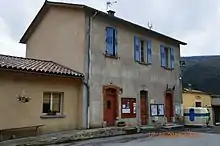
List of Successive Mayors of Allons[22]
| From | To | Name | Party |
|---|---|---|---|
| 1983 | 2014 | Élie Galfard[23][24] | PS |
| 2014 | Current | Christophe Iacobbi | DVG |
Intercommunality
Allons is a member of the Community of Alpes Provence Verdon - Sources de Lumière.
Budget and Taxation
| Tax | Communal part | Intercommunal part | Departmental part | Regional part |
|---|---|---|---|---|
| Housing Tax (TH) | 10.00% | 0.88% | 5.53% | 0.00% |
| Buildings Tax (TFPB) | 15.50% | 2.53% | 14.49% | 2.36% |
| Land Tax (TFPNB) | 40.05% | 3.33% | 47.16% | 8.85% |
| Business Tax (TP) | 16.47%* | 2.11% | 10.80% | 3.84% |
The regional share of the property tax is not applicable. The business tax was replaced in 2010 by the enterprise land premium (CFE) on the rental value of properties and the contribution of the added value of enterprises (CAVE) (both forming the territorial economic contribution).
Population
| Year | Pop. | ±% p.a. |
|---|---|---|
| 1968 | 64 | — |
| 1975 | 65 | +0.22% |
| 1982 | 62 | −0.67% |
| 1990 | 73 | +2.06% |
| 1999 | 81 | +1.16% |
| 2007 | 126 | +5.68% |
| 2012 | 142 | +2.42% |
| 2017 | 143 | +0.14% |
| Source: INSEE[26] | ||
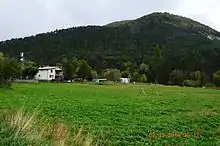

Prior to 1793 the following censuses had been taken:
- 1315: 89 fires
- 1471: 19 fires
- 1765: 359 people
Source: Édouard Baratier, Georges Duby, and Ernest Hildesheimer for the Ancien Régime[19]
Economy
The only jobs in the commune are at three farms and two masonry companies plus a campsite near the Verdon and a bar open during the summer. Much of the population works in Saint-André-les-Alpes.[27]
The Mérimée database says that in 2006 there was only one farm: a sheep farm with a golf course, hay meadows, and cereal crops.[7] Lavender is grown on some plots.[7]
Culture and heritage
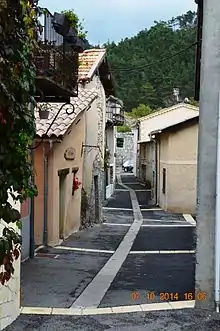
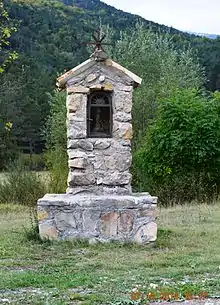
Civil heritage
The commune has a very large number of buildings and structures that are registered as historical monuments.[28]
At Vauclause, the remains of the castle are called the Saracen Tower.[7]
There are several lordly manor houses, sometimes called castles:[29]
- three in the village
- one at Vauclause in ruins
- one at La Moutière.
The old communal Oven was inaugurated in 2009 after having restoration done inside
Religious heritage
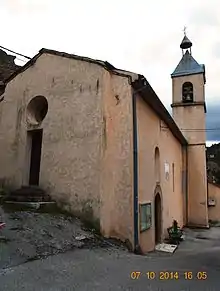
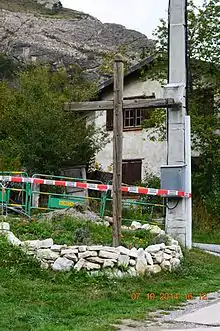
The commune has many religious buildings and structures that are registered as historical monuments:
- The Chapel of Saint Martin (in ruins) (20th century).
 [30]
[30] - The Chapel of Saint Domnin.
 [31] The Chapel contains several items that are registered as historical objects:
[31] The Chapel contains several items that are registered as historical objects:
- The Parish Church of Saint Martin (1862)
 [34] The church contains a very large number of items that are registered as historical objects.[35] Some of the more interesting items are:
[34] The church contains a very large number of items that are registered as historical objects.[35] Some of the more interesting items are:
- a bust-reliquary of Saint Domnin
 , the first Bishop of Digne, carved and gilded, placed on procession stretchers[36] and saved from destruction in 1745[20]
, the first Bishop of Digne, carved and gilded, placed on procession stretchers[36] and saved from destruction in 1745[20] - a Monstrance in the shape of the sun (19th century)
 , embossed and carved in silver[37]
, embossed and carved in silver[37] - a golden chalice (19th century)
 [38]
[38] - an ornate silver chalice signed Dejean (19th century)
 [39]
[39] - several paintings by Fidèle Patritti:
- A scene of Saints Domnin and Martin admiring the Sacred Heart
 , created before 1858[43]
, created before 1858[43] - a small statue of St. Joseph (1856)
 [44]
[44] - a small statue of the Virgin and Child (1881)
 [45]
[45]
- a bust-reliquary of Saint Domnin
- Oratories and Wayside Crosses (19th century)
 [46]
[46] - The Church of Saint-Clair de Gouts (13th century)
 [47]
[47]
Notable People linked to the commune
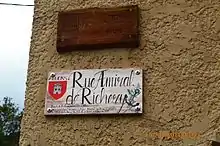
- Jean-Jacques Béraud, born in Allons in 1753 and died in Cartagena in 1794, a priest and hydraulic engineer[48]
- Joseph de Richery (1757-1798), Rear-Admiral, born and died in Allons.
- Charles Alexander Richery born in Allons,[49] Bishop of Fréjus (1823-1829), and Archbishop of Aix-en-Provence
See also
Bibliography
- Raymond Collier, Haute-Provence monumental and artistic, Digne, Jean Louis Printing, 1986, 559 p. (in French)
- Under direction of Édouard Baratier, Georges Duby, and Ernest Hildesheimer, Historical Atlas. Provence, Comtat Venaissin, principality of Orange, County of Nice, Principality of Monaco, Librairie Armand Colin, Paris, 1969 (in French)
References
- "Répertoire national des élus: les maires". data.gouv.fr, Plateforme ouverte des données publiques françaises (in French). 2 December 2020.
- "Populations légales 2020". The National Institute of Statistics and Economic Studies. 29 December 2022.
- Inhabitants of Alpes-de-Haute-Provence (in French)
- Michel de La Torre, Alpes-de-Haute-Provence : The complete Guide to 200 communes, Paris, Deslogis-Lacoste, coll. "Towns and Villages of France", 1989, Relié, 72 p. (non-paginated) (ISBN 2-7399-5004-7) (in French)
- Google Maps
- Sandre. "Fiche cours d'eau - L'Ivoire (X2030520)".
- Ministry of Culture, Mérimée IA04000581 Presentation of the commune of Allons (in French)

- Trains of Provence, Timetable Nice-Allons Argens Archived 2013-05-14 at the Wayback Machine, consulted on 25 May 2013
- Prefecture of Alpes-de-Haute-Provence, Departmental Dossier on major risks in Alpes-de-Haute-Provence, (DDRM), 2008, (in French)
- Ministry of Ecology, sustainable development, transport and accommodation, Communal Notice Archived 2016-03-03 at the Wayback Machine on the GASPAR database, created 27 May 2011, consulted on 25 June 2012 (in French)
- Dicrim of Allons, base Dicrim, consulted on 25 June 2011
- Ernest Nègre, Global Toponymy of France : etymology of 35,000 placenames, Geneva: Librairie Droz, 1990. Volume II : Formations non-romanes; formations dialectales. Notice 14291, p 826 (in French)
- Charles Rostaing, Essay on the toponymy of Provence : since its origins until the barbarian invasions, Laffite Reprints, Marseille, 1973 (1st edition 1950), p 43 (in French)
- Bénédicte Fénié, Jean-Jacques Fénié, Provençale Toponymy, Éditions Sud-Ouest, 2002 (reprint), ISBN 978-2-87901-442-5, p. 17 (in French)
- Charles Rostaing, Toponymy of Pre-Gallic origin, in Baratier, Duby & Hildesheimer, Historical Atlas. Provence, Comtat Venaissin, principality of Orange, County of Nice, Principality of Monaco, Map 11 and commentary (in French)
- Daniel Thiery, Allons Origins of Churches and Rural Chapels in Alpes-de-Haute-Provence, published on 12 December 2010, online 15 December 2010, consulted on 25 June 2012 (in French)
- Brigitte Beaujard, The Cities of southern Gaul from the 3rd to the 7th centuries, Gallia, 63, 2006, CNRS éditions, p. 22-23 (in French)
- Raymond Collier, Haute-Provence monumental and artistic, Digne, Imprimerie Louis Jean, 1986, 559 p., p 31 (in French)
- Under direction of Édouard Baratier, Georges Duby, and Ernest Hildesheimer, Historical Atlas. Provence, Comtat Venaissin, principality of Orange, County of Nice, Principality of Monaco, Librairie Armand Colin, Paris, 1969 (in French), p. 159
- Jean Nicolas, The French Rebellion: popular movements and social conscience, 1661-1789, Paris : Gallimard, 2008. Collection Folio, ISBN 978-2-07-035971-4, p. 753-754 (in French)
- Prefecture of Alpes-de-Haute-Provence, Two centuries of prefectoral activity », consulted on 25 May 2013 (in French)
- List of Mayors of France (in French)
- Élie Galfard is one of the 500 elected officials who supported the candidature of François Mitterrand (PS) at the Presidential elections of 1988, cf. constitutional council, List of citizens who presented the candidates for election of the President of the Republic, Official Journal of the French Republic of 12 April 1988, pages 47-92, available online, consulted on 29 July 2010 (in French)
- Élie Galfard is one of the 500 elected officials who supported the candidature of Daniel Gluckstein at the Presidential elections of 2002, cf Supporters for the presidential election 2002, consulted on 28 July 2010 and List of citizens who presented the candidates for election of the President of the Republic in 2002
- Local Taxes in Allons (in French)
- Population en historique depuis 1968, INSEE
- Natural Park of Verdon, "Life is only one chance, take hold of it", By nature: letter from Parc naturel régional du Verdon, no 23, Winter 2008/2009 (in French)
- Base Mérimée: Search for heritage in the commune, Ministère français de la Culture. (in French)
- Raymond Collier, Haute-Provence monumental and artistic, Digne, Imprimerie Louis Jean, 1986, 559 p., p 274 (in French)
- Ministry of Culture, Mérimée IA04001126 Chapel of Saint Martin (in French)

- Ministry of Culture, Mérimée IA04001117 Chapel of Saint Domnin (in French)

- Ministry of Culture, Palissy IM04001700 Statuette of the Child Jesus (in French)

- Ministry of Culture, Palissy IM04001698 Furniture in the Chapel of Saint Domnin (in French)

- Ministry of Culture, Mérimée IA04000139 Parish Church of Saint Martin (in French)

- Search results Base Palissy
- Ministry of Culture, Palissy PM04001233 Reliquary Bust (in French)

- Ministry of Culture, Palissy PM04001231 Monstrance (in French)

- Ministry of Culture, Palissy PM04001230 Chalice (in French)

- Ministry of Culture, Palissy PM04001229 Chalice (in French)

- Ministry of Culture, Palissy PM04001228 Painting: The Resurrection (in French)

- Ministry of Culture, Palissy PM04001227 Painting: The Annunciation (in French)

- Ministry of Culture, Palissy PM04001226 Painting: The Rosary (in French)

- Ministry of Culture, Palissy PM04001225 Painting: The Sacred Heart (in French)

- Ministry of Culture, Palissy PM04001223 Statue: Joseph (in French)

- Ministry of Culture, Palissy PM04001222 Statue: The Virgin (in French)

- Ministry of Culture, Mérimée IA04000412 Oratories and Wayside Crosses (in French)

- Ministry of Culture, Mérimée PA00125247 Church of Saint Clair de Gouts (in French)
- Under direction of Édouard Baratier, Georges Duby, and Ernest Hildesheimer, Historical Atlas. Provence, Comtat Venaissin, principality of Orange, County of Nice, Principality of Monaco, Librairie Armand Colin, Paris, 1969 (in French), p. 153
- Almanac of the clergy of France for 1828, Guyot et Scribe éditeurs, Paris, 1828, p. 222 (in French)
External links
- Allons and Argens Station on the Chemins de fer de Provence website (in French)
- On the History of Allons, a site gathering numerous historical documents and information] (in French)
- Allons on Géoportail, National Geographic Institute (IGN) website (in French)
- Allons on the 1750 Cassini Map